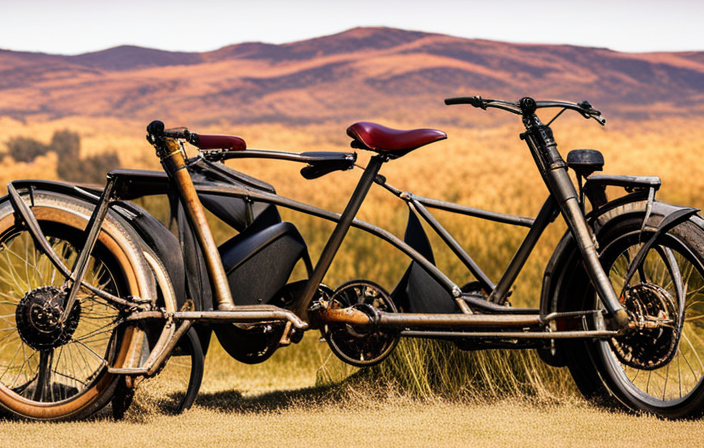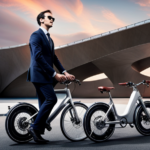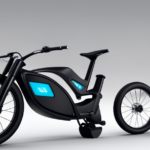How many amp hour battery does an electric bike need?
As an avid cyclist, I’ve often pondered this question. The battery is the lifeblood of an electric bike, determining its power and range.
In this article, we will delve into the technical aspects of electric bike batteries, exploring how to calculate your power needs, the different types of batteries available, and the importance of matching battery capacity to your riding style.
Join me on this journey to find the perfect battery for your electric bike.
Key Takeaways
- Choosing the right amp hour battery is crucial for compatibility with an electric bike.
- Bike motor compatibility determines the overall performance and efficiency of the electric bike.
- Battery size should be considered based on the motor power and the weight of the bike.
- Larger motors may require higher amp hour batteries, while heavier bikes may need larger battery capacity.
Understanding Electric Bike Batteries
An electric bike typically requires a battery with a certain number of amp hours. Understanding electric bike batteries is crucial when considering the range and performance of your electric bike.
The amp hours (Ah) of a battery determine how much energy it can store. This is important because it directly affects the range of your electric bike. Battery chemistry plays a significant role in determining the amp hours of a battery.
Lithium-ion batteries, for example, are commonly used in electric bikes due to their high energy density and long lifespan. When calculating your power needs, it is essential to consider factors such as terrain, rider weight, and desired speed.
By understanding battery chemistry and calculating your power needs, you can choose the right battery with the appropriate amp hours for your electric bike, ensuring optimal performance and range.
Calculating Your Power Needs
Calculating your power needs for an e-bike can be done by determining the required amp hour capacity of the battery. To accurately calculate this, you need to consider your power consumption and desired battery range.
Firstly, you should determine the power consumption of your e-bike. This can be calculated by multiplying the voltage of your e-bike’s motor by the current it draws. Once you have this value, you can estimate the amount of time you will be riding your bike on a single charge.
Next, you need to consider the battery range. This is the distance your e-bike can travel on a single charge. To calculate the required amp hour capacity, divide the power consumption by the battery range. This will give you an estimate of the amp hour capacity needed for your e-bike’s battery.
In the subsequent section about ‘types of electric bike batteries’, we will explore the different options available to meet your power needs.
Types of Electric Bike Batteries
There are various types of e-bike batteries available to meet your power requirements. When considering the type of battery for your electric bike, it is important to understand the battery chemistry and its impact on performance.
The most common types of batteries used in electric bikes are lithium-ion and lithium polymer batteries. These batteries offer high energy density, allowing for a longer range and better overall performance. Additionally, they have a longer lifespan compared to other battery chemistries, ensuring that you get the most out of your investment.
It is important to note that the battery lifespan can be affected by factors such as temperature, charging and discharging cycles, and overall maintenance. Understanding the different types of electric bike batteries and their characteristics is crucial in determining the right battery for your needs.
This knowledge will ensure optimal amp hour rating and battery performance in the subsequent section.
Amp Hour Rating and Battery Performance
The amp hour rating directly affects the performance of the battery. The higher the amp hour rating, the longer the battery can provide power. It is important to choose a battery with the right amp hour rating for your electric bike to ensure optimal performance.
Here are some key factors to consider:
-
Battery capacity: The amp hour rating determines the capacity of the battery, which is the amount of energy it can store. A higher amp hour rating means a larger capacity and longer riding time.
-
Battery lifespan: The amp hour rating also affects the lifespan of the battery. Generally, batteries with higher amp hour ratings tend to have a longer lifespan.
-
Efficiency: Higher amp hour batteries may have a lower efficiency, meaning they may lose more energy during charging and discharging.
-
Weight: Batteries with higher amp hour ratings are usually heavier, which can affect the overall weight and balance of the electric bike.
-
Cost: Batteries with higher amp hour ratings are typically more expensive.
Matching the battery capacity to your riding style is crucial for optimal performance and longevity.
Matching Battery Capacity to Your Riding Style
To optimize performance and longevity, it’s important to match the capacity of the battery to your riding style. The battery capacity, measured in amp hours (Ah), determines how long the battery can provide power to your electric bike. It’s crucial to select a battery with enough capacity to meet your riding demands. Considerations such as distance, terrain, and speed all play a role in determining the appropriate battery capacity.
To help you visualize the relationship between battery capacity and riding style, consider the following table:
| Riding Style | Battery Capacity (Ah) |
|---|---|
| Casual | 10-15 |
| Commuter | 15-20 |
| Long-distance | 20+ |
Matching your battery capacity to your riding style ensures you have enough power to complete your rides comfortably. Moving forward, let’s explore considerations for battery charging.
Considerations for Battery Charging
When charging your battery, you should consider factors such as charging time and frequency to ensure optimal performance and longevity.
To optimize the charging time, it is important to use a charger with the appropriate voltage and current output that matches the battery’s specifications. Additionally, utilizing a higher amperage charger can reduce the charging time, but it may also increase the risk of overheating or damaging the battery if not carefully monitored.
It is recommended to charge the battery at a moderate rate to maintain its health and extend its lifespan. Furthermore, it is crucial to avoid overcharging the battery as it can lead to decreased capacity and performance over time.
By following these battery charging considerations and optimizing the charging time, you can ensure that your electric bike’s battery performs at its best.
Moving forward, let’s explore some important aspects of battery maintenance and care.
Battery Maintenance and Care
When it comes to battery charging for electric bikes, there are a few considerations to keep in mind. However, it is equally important to focus on battery maintenance and care to ensure optimal performance and longevity.
Proper battery storage is crucial to prevent any damage or deterioration. It is recommended to store the battery in a cool, dry place, away from extreme temperatures and direct sunlight. Additionally, regular cleaning of the battery terminals and connectors can help maintain a strong connection and prevent any corrosion.
Another key aspect of battery care is extending its life. This can be achieved by avoiding deep discharge cycles and keeping the battery charged between 20% and 80% capacity.
By following these maintenance practices, you can maximize the lifespan and effectiveness of your electric bike battery.
Now, let’s delve into the next section about upgrading your electric bike battery.
Upgrading Your Electric Bike Battery
When upgrading your electric bike battery, it is important to consider its compatibility with both the bike and motor. Ensuring that the new battery is compatible with the existing components will prevent any potential damage or malfunction.
Additionally, it is recommended to have the battery professionally installed to avoid any mistakes or mishaps during the installation process.
Lastly, it is crucial to check the warranty of the new battery to guarantee its quality and reliability, providing peace of mind for the rider.
Compatibility with Bike and Motor
To ensure compatibility with your bike and motor, you’ll need to choose the right amp hour battery. Bike motor compatibility is crucial as it determines the performance and efficiency of your electric bike.
When selecting the battery size, consider the power requirements of your motor and the weight of your bike. A larger motor may require a higher amp hour battery to provide sufficient power and range. Additionally, the weight of your bike affects the battery’s performance, so a heavier bike may necessitate a larger battery capacity.
Choosing the right battery size ensures optimal performance and longevity for your electric bike.
Now, moving on to the next section about professional installation and warranty, it is important to consider these aspects to ensure a seamless transition and protect your investment.
Professional Installation and Warranty
When it comes to installing an electric bike battery, it is crucial to seek professional installation to ensure compatibility and optimal performance. Professional installation ensures that the battery is properly integrated with the bike and motor, minimizing any potential issues that could arise from a DIY installation. Additionally, professional installation often comes with a warranty, providing peace of mind and protection for your investment. The battery warranty typically covers any defects or malfunctions that may occur within a specified period, offering reassurance that you are covered in case of any unforeseen problems. This warranty is an important factor to consider when selecting an electric bike battery, as it reflects the manufacturer’s confidence in their product’s quality and durability. Moving forward, let’s explore eco-friendly battery options that can further enhance your electric bike experience.
Eco-friendly Battery Options
When discussing eco-friendly battery options, it’s important to consider sustainable battery materials, recycling, and disposal of batteries.
Sustainable battery materials refer to the use of environmentally friendly materials in the production of batteries, such as those that are non-toxic and easily recyclable.
Recycling and proper disposal of batteries are crucial to minimize their impact on the environment, as they can contain hazardous materials that can be harmful if not handled correctly.
By focusing on these key points, we can ensure that our battery options are not only efficient but also sustainable and environmentally responsible.
Sustainable Battery Materials
The sustainable battery materials used in electric bikes are becoming more efficient. With a focus on sustainable battery production and the development of future battery technology, manufacturers are constantly seeking ways to improve the performance and longevity of electric bike batteries.
One of the key advancements in sustainable battery materials is the use of lithium iron phosphate (LiFePO4) as the cathode material. LiFePO4 batteries have a longer cycle life, higher thermal stability, and improved safety compared to traditional lithium-ion batteries.
Additionally, manufacturers are exploring the use of other sustainable materials such as graphene and silicon for anode materials to enhance the energy density and overall performance of electric bike batteries. These advancements in sustainable battery materials pave the way for a more environmentally friendly and efficient electric bike industry.
As we delve into the topic of recycling and disposal of batteries, it is essential to consider the impact of these materials on the environment.
Recycling and Disposal of Batteries
Recycling and disposal of batteries is crucial for minimizing environmental impact and ensuring the sustainable development of electric bike technology. Proper recycling methods help in reducing the negative consequences that arise from the improper disposal of batteries. To emphasize the importance of recycling and disposal, consider the following sub-lists:
-
Recycling methods:
-
Mechanical processes: involve crushing and shredding batteries to separate different materials.
-
Hydrometallurgical processes: use chemical solutions to extract valuable metals like lithium and cobalt.
-
Pyrometallurgical processes: involve high-temperature treatments to recover metals from batteries.
-
Environmental impact:
-
Hazardous substances in batteries, such as lead and mercury, can contaminate soil and water sources.
-
Landfills filled with discarded batteries contribute to pollution and waste.
-
Extracting raw materials for new batteries leads to resource depletion and environmental degradation.
Choosing the right battery for your electric bike is a crucial step in ensuring optimal performance and longevity.
Conclusion: Choosing the Right Battery for Your Electric Bike
To choose the right battery for your electric bike, you should consider the amp hour capacity. This refers to the amount of current the battery can deliver over a certain period of time. It is important to choose a battery with a sufficient amp hour capacity to meet your specific needs and riding style.
When looking at different batteries, it is also crucial to consider their lifespan and the pros and cons of different battery chemistries. Some common battery chemistries used in electric bikes include lithium-ion, nickel-metal hydride, and lead-acid. Each has its own advantages and disadvantages in terms of energy density, weight, cost, and environmental impact.
To make the decision-making process easier, I have created a table that compares these battery chemistries based on key factors:
| Battery Chemistry | Energy Density | Weight | Cost | Environmental Impact |
|---|---|---|---|---|
| Lithium-ion | High | Light | High | Low |
| Nickel-metal hydride | Medium | Medium | Medium | Medium |
| Lead-acid | Low | Heavy | Low | High |
By considering the amp hour capacity and comparing the pros and cons of different battery chemistries, you can make an informed decision and choose the right battery for your electric bike.
Frequently Asked Questions
Can I use a higher amp hour battery for my electric bike to increase its range?
Using a higher voltage battery for my electric bike can increase its range. The advantage is that it allows for more power and longer rides. However, the disadvantage is that it may require modifications and could be more expensive.
What is the average lifespan of an electric bike battery?
The average lifespan of an electric bike battery depends on various factors, such as usage patterns, charging practices, and environmental conditions. Factors like average charging time and proper maintenance also play a crucial role in determining the battery’s lifespan.
Are there any safety precautions I should take when handling or charging my electric bike battery?
When handling or charging my electric bike battery, I take safety precautions seriously. It’s crucial to follow manufacturer guidelines, wear protective gear, and ensure a well-ventilated area. Safety first to avoid any potential accidents or damage.
Can I charge my electric bike battery with a solar panel?
Yes, you can charge your electric bike battery with a solar panel. It offers several benefits such as eco-friendliness, cost-saving, and convenience. Solar panels convert sunlight into electricity, providing a sustainable and renewable energy source for charging your electric bike battery.
How do I dispose of an old electric bike battery in an environmentally friendly way?
To dispose of an old electric bike battery in an environmentally friendly way, I recommend recycling it. Many local recycling centers or retailers offer battery recycling programs that ensure proper disposal and reduce environmental impact.
Conclusion
In conclusion, choosing the right battery for your electric bike is crucial for optimal performance. By understanding electric bike batteries and calculating your power needs, you can determine the amp hour rating required.
It’s important to match the battery capacity to your riding style to ensure sufficient power throughout your journeys. Regular maintenance and care will prolong the battery’s lifespan, and upgrading to eco-friendly options can be a great choice.
So, why settle for anything less than the perfect battery for your electric bike?
















